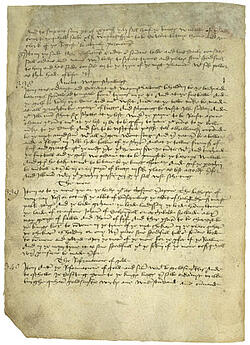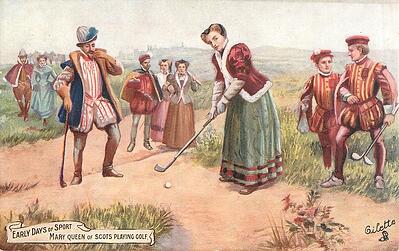The origins of golf can be traced all the way back to 100 BCE. The ancient Romans played a game known as paganica, where participants hit a stuffed leather ball with a bent stick. Another game similar to golf, chuíw án, was played during the Song dynasty in China, fro around 960 to 1279. The game evolved considerably over time, and the precise origins of today's game are unknown. Both the French and the Dutch have claimed credit, citing similar games as evidence: jeue de mail and kolven respectively. But both these games lack an essential element of modern golf: the hole.
A Sport with Unknown Origins
Most evidence indicates that golf as we know it today originated in Scotland, though the exact area where the game began is unknown. The earliest mentions of golf in the Kirk Session (church court) are from the east coast of Scotland. In the sixteenth and seventeenth centuries, it wasn't uncommon for parishes to  punish members who played golf "at the time of the preaching of the Sermon," that is, skipping church to play golf.
punish members who played golf "at the time of the preaching of the Sermon," that is, skipping church to play golf.
It was such a problem that by 1599, St. Andrews had a system of penalties in place: the first two offenses resulted in small fines, after which the church would impose the "repentance pillar." If that didn't work, the parishioner would be "deprived of office," otherwise known as being excommunicated.
The first written record of the game appeared on March 6, 1457, in an Act of Parliament by James II of Scotland. This legislation actually banned playing golf and football (soccer)! Some scholars argue that by this time, golf must have already been a national pastime, if it was such a common activity that legislation was required to curtail practicing the sport. It's known that the game was played at St. Andrews long before it was founded as a university in 1411.
Golf Threatens National Defense
But why would James II ban the game? And why would the ban be reinforced in both 1471 and 1491? James II had little power as a monarch, but the Scottish nobility was quite powerful. Meanwhile, Scotland faced an almost constant threat of invasion from England. Thus, military training was mandatory for all males over the age of twelve.
Unfortunately, most men preferred to play golf or soccer in their spare time, rather than practicing archery and marksmanship. People frequently played these games on public streets and in churchyards. James II and his parliament therefore considered it a dangerous nuisance and "unprofitable" to spend time playing these games. The ban was largely ignored, even though subsequent monarchs attempted to reinforce it. It turned out, however, that James II's concern was not misplaced. In 1513, Scottish soldiers were dominated by English troops in the first assault at Flodden--mostly because they had such terrible marksmanship.
Golf Goes to (Royal) Court
By the sixteenth century, golf had become a popular sport among the genteel and wealthy. James IV, who'd initially tried to reinforce the ban on the game, eventually succumbed and took up the sport himself. In 1501, the royal treasurer paid a Perth bowmaker to supply golf clubs, and numerous golf-related expenses appear on the ledger thereafter.
 Later, Mary Queen of Scots was also an avid player. She famously played with--and lost to--her attendant Mary Seton. She gave the attendant a necklace in honor of her victory. Mary also came under scrutiny when she indulged in a game of golf only a few days after her husband, Lord Darnley was murdered in 1567. By that time, Archbishop Hamilton had already published a Charter (1552) recognizing the right of the people of St. Andrew's to play golf on the Old Course.
Later, Mary Queen of Scots was also an avid player. She famously played with--and lost to--her attendant Mary Seton. She gave the attendant a necklace in honor of her victory. Mary also came under scrutiny when she indulged in a game of golf only a few days after her husband, Lord Darnley was murdered in 1567. By that time, Archbishop Hamilton had already published a Charter (1552) recognizing the right of the people of St. Andrew's to play golf on the Old Course.
In 1603, King James VI of Scotland ascended the English throne and became King James I of England. He and his court brought golf with them, and they soon began playing the game at Blackheath in London. It was only a matter of time before the game spread beyond the boundaries of Great Britain, though it took longer than one might imagine; the first reference to golf wasn't made in the United States until 1729, when a set of golf clubs was recorded as part of the estate of William Burnett, the governor of Massachusetts. And it wasn't until 1744 that official rules for the game of golf were established by the Honourable Company of Edinburgh Golfers.
Today, golf is one of the world's beloved pastimes. It's been played at the Olympics, where it will reappear in 2016. And every year, millions of people not only take to the links themselves, but also tune in to watch exceptional amateur and professional athletes compete in golf tournaments around the world. An entire literature of golf has sprung up, particularly in the fifty years. Many a collector has built a delightful personal library with the rare books of golf.









